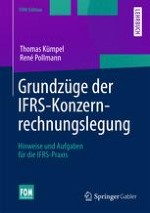2014 | OriginalPaper | Buchkapitel
7. Behandlung von Gemeinschaftsunternehmen, gemeinschaftlichen Vereinbarungen und assoziierten Unternehmen
verfasst von : Thomas Kümpel, René Pollmann
Erschienen in: Grundzüge der IFRS-Konzernrechnungslegung
Verlag: Springer Fachmedien Wiesbaden
Aktivieren Sie unsere intelligente Suche, um passende Fachinhalte oder Patente zu finden.
Wählen Sie Textabschnitte aus um mit Künstlicher Intelligenz passenden Patente zu finden. powered by
Markieren Sie Textabschnitte, um KI-gestützt weitere passende Inhalte zu finden. powered by
